Barbodes semifasciolatus
Golden Barb*
SynonymsTop ↑
Barbus semifasciolatus Günther, 1868; Puntius semifasciolatus Günther, 1868; Barbus fasciolatus Günther, 1868: Barbus aureus Tirant, 1883; Barbus sachsii Ahl, 1923; Barbus hainani Lohberger, 1929; Puntius hainanensis Chevey & Lemasson, 1937; Barbus fernandez-ypezi Fowler, 1958; Puntius paucimaculatus Wang & Ni, 1982
Etymology
Barbodes: from the Latin barbus, meaning ‘barbel’, and Ancient Greek εἶδος (-oides), meaning ‘form, likeness’.
semifasciolatus: from the Latin semi, meaning ‘half’, and fasciolatus, meaning ‘with small bands’.
Classification
Order: Cypriniformes Family: Cyprinidae
Distribution
Occurs throughout Vietnam, Taiwan, and southwestern China and northern Laos, and has also been recorded in Russia though it’s unclear whether the latter population is naturally-occurring or not.
Type locality is given as ‘China’ but the type specimens appear to have been collected from the Red River drainage (probably the northern Vietnam section although the river originates in Yunnan province, China), and occurence records show that it’s also been collected from numerous other localities in northern Vietnam, the Chinese provinces of Guangxi and Guangdong and the islands of Hainan, Hong Kong, and Taiwan.
Information pertaining to Laos is scant but the species certainly occurs in the Nam Ou river watershed, Phôngsali Province. In Taiwan the species is known to be at risk through habitat loss/degradation and the introduction of exotic species, while feral populations exist in both Singapore and Hawaii.
Habitat
Appears to display a preference for slower-flowing tributaries and standing water bodies such as swamps and irrigation channels and is fairly ubiquitous in such biotopes across its range.
It’s typically associated with areas of dense aquatic or riparian vegetation and forms schools close to the substrate.
At a typical stream locality on Hainan Island the water was around 1 metre deep with temperature 31.9°C, pH 8.0, conductivity 102 µS/cm, GH 2, and kH 2 in March 2006.
Sympatric species included Rasbora steineri, Macropodus opercularis, Doryichthys sp., and Metzia spp. with several species of shrimp from genera such as Macrobrachium and Neocaridinia also present.
Maximum Standard Length
65 – 75 mm.
Aquarium SizeTop ↑
Base dimensions of at least 90 ∗ 30 cm or equivalent are required.
Maintenance
The golden form (see ‘Notes’) is among the hardier, most undemanding species available in the aquarium hobby and as such is a good choice for beginners.
Choice of décor is not especially critical though it tends to show better colouration in a heavily-planted set-up with a dark substrate.
The addition of some floating plants and driftwood roots or branches to diffuse the light entering the tank also seems to be appreciated and adds a more natural feel.
Filtration does not need to be particularly strong though it does seem to appreciate a degree of water movement and will also do well in a hill stream-type set-up.
Water Conditions
Temperature: 16 – 24 °C
pH: 6.0 – 8.0
Hardness: 36 – 357 ppm
Diet
A foraging omnivore feeding mostly on benthic diatoms, algae, organic detritus, small insects, worms, crustaceans, and other zooplankton in nature.
In the aquarium it’s easily-fed but the best condition and colours offer regular meals of small live and frozen foods such as bloodworm, Daphnia, and Artemia alongside good quality dried flakes and granules, at least some of which should include additional plant or algal content.
Behaviour and CompatibilityTop ↑
Generally very peaceful making it an ideal resident of the well-researched community aquarium.
Fishes inhabiting similar biotopes in nature, especially comparably-sized, peaceful cyprinids perhaps constitute the best choices but other potential options include balitorid, cobitid, and nemacheilid loaches as well as benthic cyprinids such as Crossocheilus and Garra species.
Try to buy a mixed-sex group of at least 8-10 specimens, include other schooling fishes to provide security, and you’ll be rewarded with a more natural-looking spectacle.
The interaction between rival males is interesting to watch and they will display their best colours when competing for female attention or hierarchical position.
Sexual Dimorphism
Adult females tend to be rounder-bellied and grow slightly larger than the males.
In the natural colour form sexually mature males develop red pigmentation in the lower portion of the body.
Reproduction
Like most small cyprinids ‘Puntius‘ spp. are egg-scattering free spawners exhibiting no parental care.
When in good condition they will spawn often and in a mature aquarium it’s possible that small numbers of fry may start to appear without intervention.
However if you want to maximise yield a more controlled approach is required.
The adult group can still be conditioned together but a smaller aquarium should also be set up and filled with mature water.
This should be very dimly lit and the base covered with some kind of mesh of a large enough grade so that the eggs can fall through but small enough so that the adults cannot reach them. The widely available plastic ‘grass’-type matting can also be used and works well, as does a layer of glass marbles.
Alternatively filling much of the tank with a fine-leaved plant such as Taxiphyllum spp. or spawning mops can also return decent results.
The water itself should be of slightly acidic to neutral pH with a temperature towards the upper end of the range suggested above, and an air-powered sponge filter or air stone(s) should also be included to provide oxygenation and water movement.
When the adults are well-conditioned and the females appear gravid one or two pairs should then be introduced, and spawning should take place the following morning.
An alternative is to spawn the fish in a group with half a dozen specimens of each sex being a good number, although a larger aquarium may be necessary.
In either situation the adults will probably eat the eggs given the chance and should be removed as soon as any are noticed.
These should hatch in 24 – 48 hours with the fry free swimming around 24 hours later.
They should be fed on an infusoria-grade food for the first few days until large enough to accept microworm, Artemia nauplii, or suchlike.
NotesTop ↑
This species is also known by the alternative names ‘green’ or ‘Chinese’ barb.
The natural ‘green’ form is an infrequent find in the aquarium trade whereas the selectively-bred ‘golden’ variant is farmed in huge numbers and is among the most popular freshwater aquarium fishes.
It was first produced in the 1960s and is now so ubiquitous that many hobbyists are unaware that it is not the natural form.
Unfortunately the commercially-produced fish are largely inbred and evidently have been for many generations. The fins in particular seem to be reduced in size when compared with wild examples and other deformities are not uncommon.
An albino form is also available from time-to-time.
In aquarium literature the golden form is often referred to as ‘Barbus/Puntius schuberti‘ but this is not an official scientific name and was invented for American Thomas Schubert, who is credited with first developing the ornamental strain.
Puntius sachsii (Ahl, 1923) is also in common use, but its validity is in doubt and it’s currently considered an ‘uncertain’ synonym of ‘P.‘ semifasciolatus.
Puntius snyderi Oshima, 1919 has been considered synonymous with B. semifasciolatus but is currently treated as distinct.
This species was formerly included in the genus Puntius which was for a number of years viewed as a polyphyletic catch-all containing over 100 species of small to mid-sized cyprinid until Pethiyagoda et al. (2012) published a partial review covering South Asian members.
The majority of sub-Himalayan Puntius species were reclassified and new genera Dawkinsia, Dravidia (subsequently amended to Haludaria), and Pethia erected to accommodate some of them, with the remainder either retained in Puntius or moved to the existing Systomus assemblage, though the definition of the latter was altered meaning some Southeast Asian species formerly placed there could no longer be considered members.
Kottelat (2013) published a comprehensive nomenclatural update for Southeast Asian fishes in which this species was among a number of former Puntius transferred into the genus Barbodes, albeit tentatively since B. semifasciolatus “may represent a distinct lineage”. Members are told apart from related genera by the following aspects of ontogeny and colour pattern: small juveniles have 3-5 dots along the midlateral scale row, including one at middle of caudal- fin base, and an additional one at dorsal-fin origin; with increasing size, the spots on midlateral row may become more numerous and may fuse to form a stripe or broad band, and the spot at dorsal-fin origin may become a large blotch or a broad bar.
In addition, the following characters are useful in identification of Barbodes spp.: last simple dorsal-fin ray serrated posteriorly; rostral barbels present (except in B. aurotaeniatus); maxillary barbels present; lips smooth and thin, postlabial groove interrupted medially; lateral line complete or not, with 22–32 scales on lateral line row on body; ½4/1/4½ scale rows between dorsal-fin origin and ventral midline in front of pelvic-fin base; 12 circumpeduncular scale rows; 12–15 gill rakers on first gill arch.
References
- Günther, A., 1868 - Catalogue of the fishes in the British Museum v. 7: i-xx + 1-512
Catalogue of the Physostomi, containing the families Heteropygii, Cyprinidae, Gonorhynchidae, Hyodontidae, Osteoglossidae, Clupeidae,... [thru]... Halosauridae, in the collection of the British Museum. - Chang, C-H, Y-T Shao, and H-W Kao, 2006 - Zoological Studies 45(2): 149-156
Molecular Identification of Two Sibling Species of Puntius in Taiwan. - Chen, I-S, and Y-C Chang, 2005 - The Sueichan Press: i-xx + 1-284
A Photographic Guide to the Inland-water Fishes of Taiwan: Vol. 1 Cypriniformes. - Kottelat, M., 2001 - WHT Publications, Colombo: 1-198
Fishes of Laos. - Kottelat, M., 2013 - The Raffles Bulletin of Zoology Supplement 27: 1-663
The fishes of the inland waters of southeast Asia: a catalogue and core bibiography of the fishes known to occur in freshwaters, mangroves and estuaries. - Kullander, S. O. and F. Fang, 2005 - Copeia 2005(2): 290-302
Two new species of Puntius from northern Myanmar (Teleostei: Cyprinidae). - Pethiyagoda, R., 2013 - Zootaxa 3646(2): 199
Haludaria, a replacement generic name for Dravidia (Teleostei: Cyprinidae). - Pethiyagoda, R., M. Meegaskumbura, and K. Maduwage, 2012 - Ichthyological Exploration of Freshwaters 23(1): 69-95
A synopsis of the South Asian fishes referred to Puntius (Pisces: Cyprinidae).


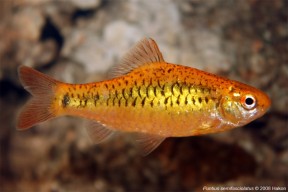


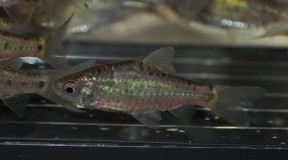
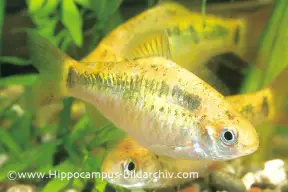

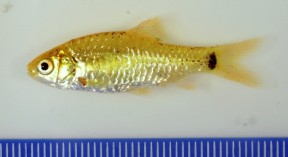
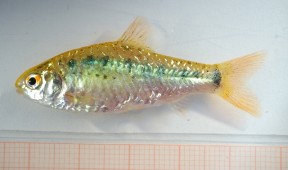
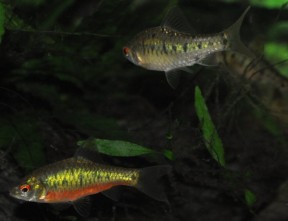

November 17th, 2012 at 6:01 pm
I am lucky enough to have sourced several specimens of the wild form of this fish and I can truly say that they are even more beautiful than the hybrid form,once they have acclimatised themselves to the aquarium.With their metalic green cordal line and reddy brown fins,truly beautiful and well worth the effort to source this beautiful fish.Cheers,norjean09.
August 12th, 2020 at 9:20 pm
I simply had a question (please forgive if this is not allowed, I read the FAQ but I was not sure). I was wondering if there is any evidence of offspring from the ‘golden form’ ever reverting back to the wild-type coloration? That is to say, do we see some fish with wild-type coloration in any given group of offspring (such as random wild-type Neocaridina individuals) or has the strain been around/been inbred so long that the ‘green’ gene has essentially been drowned out?